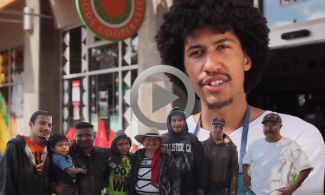Cooperation: Unique Prescription for Health
Mondragon and Steelworkers Union Alliance
Cooperatives and Peace
Overcoming Barriers
Ohio City Bike Cooperative tour
Today was another amazing day of presentations at the ACE conference!....
Unlike other conferences that I'm used to attending, you don't have to choose from workshops at the Association of Cooperative Educators. There is only one track, and everyone is on the same one.
I actually ended up being very glad that it was arranged this way, else I might have missed out some very important information and stories.
First up, Asset Building 101: Why the Asset Building Movement Matters for Co-ops led by Heather McCulloch, founder of Asset Building Strategies, based in San Francisco.
The asset-building movement has gone mainstream, Heather said. However, "shared ownership," is not on the agenda. Part of her work has been to survey people and organizations to work on ways to change this.
This is relevant to co-ops because many local, state and regional programs are being started to promote asset building. "A lot of public resources are coming down," she said. Housing cooperatives and worker cooperatives could benefit from them as initial cooperative buy-ins could be funded through strategies such as Individual Development Accounts.
Heather has helped bring IDAs and assets counseling to the San Francisco Bay Area WAGES cooperative, a cleaning co-op with many immigrants. Another example of co-ops using asset-building is the Evergreen Cooperative is looking at offering forgiveable loans to employees to them purchase homes, she said.
Carol Coren, of Cornerstone Ventures in Southampton, PA, during the questions portion of the workshop, stated that an IDA management teams be educated because "the co-op movement is absent in training," she said.
Heather announced that she will be doing a presentation at the U.S. Federation of Worker Cooperatives conference in Berkeley Aug. 6-8.
For information "to get grounded in asset building, Heather recommends the New America Foundation (www.assetbuilding.org). Her website is www.AssetBuildingStrategies.com.
The Unique Prescription was one of the best stories I had heard about how cooperatives can change the economic reality of a region, true community economic development. This is the story of how a producer co-op spontaneously got organized around a hospital's desire to buy local food in Western Wisconsin, and how as a result of that work, the region would be able to provide food for itself in the event of a disaster.
The hospital is Sacred Heart Hospital in Eau Claire, WI, and its Director of Hospitality Services Rick Beckler. He and Dick Walders, a farmer in Ewes Rule the Farm in Cornwell, WI and co-op advisor Pam Herdrich told the story of the birth of the Producers & Buyers Co-op in the Chippewa Valley.
Rick was trying to buy local food for the hospital. He had a mission to spend 10% of the hospital's $2 million food budget, but was finding it difficult to do. He had made a sale with one bison farmer, but hadn't heard from her again. Sacred Heart wanted to serve grass-fed animals to their patients.
"It has a healing benefit," he explained. "It has a lot to do with the recovery of the patient." But local farmers had had bad experiences with institutions and were reluctant to take risks.
"When we looked for a model to get local and healthy food for our hospital it wasn't there," Rick said.
He met Pam at a conference and asked her why it was so difficult to buy from the local farmers. They talked, and on the spot pulled together a steering committee of farmers to work on a plan.
The result was the Producers & Buyers Co-op comprised of producers, processors, delivery persons and buyers. Members paid $50 each and they raised $250,000 by selling shares to friends and family.
The making of a successful cooperative has created jobs in an economy that was in a downturn. Rick said now there are 1,000 vacant jobs looking for employees. "I think we have a lot to do with that," he said.
Patient satisfaction has been high, he said. Patients call him up ecstatic that "you're buying meat from my neighbors." Others love the taste of the locally-raised fish.
The network of farmers can successfully meet the needs of the hospital and other institutions and Rick no longer has a problem with meeting his goals. The co-op infrastructure has become a pilot project that leads to food independence. They even grow vegetables in when it's cold and snowy in the "great white north,"
Rick said.
"The Chippewa Valley can feed itself, if necessary," Pam agreed.
Another key benefit of the cooperative is food security. The cooperative is conscious about food safety and has prohibits feeding animals certain foods that could make animals susceptible to health issues. Rick said the history of the animals can be traced. Some farmers name their animals and know their histories and peculiarities.
It was a great story about how the cooperative got organized, how local food was used, and how it helps to heal patients, and caused enthusiasm in the hospital with the cooks because the food tasted better and with patients because they knew the farmers. This story could be winner if the 2012 Co-op Stories and History Project materializes.
ACE will be make the workshops available online with RSS feed which can be downloaded. I suggest readers check this one out. Rick's humor made the story even better.
I must say though, as a mostly vegan eater, I was stunned to find out from the presentation that once an animal is butchered, it has to hang for 21 days to drain the blood from it. That aside, I was intrigued by the local food/sustainability-health/hospital-cooperative connection.
As the presenters said, they have created a model that farmers everywhere can follow, and they are excited about it. That was the beauty of the presentation.
STAYED TUNED...more coming. I'm especially excited about the Mondragon, Cooperatives and Peace and the Overcoming Barriers presentations. I'll have to write about them later, along with the Evergreen buzz, which I had planned to write about today. However, the day was so information-rich, it is a bit difficult to catch up.
There was also a great presentation by John Logue's wife on The John Logue award at the ACE awards banquet, but I regret I'll have to write tomorrow.
It's 11:59, and they get started early at ACE!



Add new comment